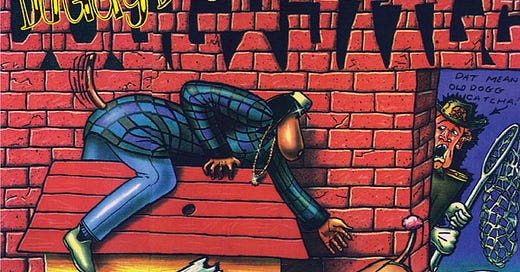Genre of the Day - G-Funk
Album of the Day - Doggystyle by Snoop Dogg (1993)
First of all, I wish you all a happy commencement to the 2024 Olympics; if only I was there like Coachella to cover the musical aspects of the games. Nonetheless, the Olympics are one of the only events that’s engaging and tantalizing enough that watching it on TV doesn’t perceptibly diminish the experience. I was surprised but pleased to see Snoop Dogg pop up in NBC’s coverage of a swimming event, discussing his newfound love of swimming events. The man has mastered the art of bringing an easy enthusiasm to any media setting he finds himself in his transition from one of the biggest rap stars of the 1990s to an America’s enterprising, stoner-idol sweetheart. In that process, he’s never changed his signature early ‘90s style—save for a brief dip into Rastafarianism—and armed with the power of two Gs in his name, he still carries the power of LA’s G-funk iconic aura to the G-lobe.
G-funk was one of the most irrefutable pieces of evidence that rap would never be a fad left in the ‘80s, as some allegations suggested, and aided the genre in reaching new levels of commercial longevity and celebrity with a touch of California flair. While it seems obvious in hindsight that hip-hop’s poetry and stylistic range would go on to take on the world, the state of it in the early ‘90s was shocking to many a pearl-clutcher; between 2 Live Crew’s raunchiness over in Miami and N.W.A.’s brash rebuttals to police violence, willfully misinterpreted by swathes of white politicians and audiences as promoting violence and mayhem, many hoped and prayed that it would pass over. Talented rappers and producers electrified audiences and reinvigorated local identities, and G-funk did so for Los Angeles at a crucial moment in the wake of N.W.A. disbanding, leaving a massive hole in what N.W.A. described as ‘reality rap’ reporting life in their communities without media spins and what journalists branded ‘gangster rap.’
G-funk plays on the name and the sounds of Parliament-Funkadelic as their defining ‘70s funk and Afrofuturism had come to the twenty-year boiling point of nostalgia. Increasingly decried by establishment media and politicians in the wake of the 1992 Los Angeles riots protesting the killing of Rodney King, N.W.A.’s former members attempted to weather the storm and take cover in various behind-the-scenes pursuits. Ice Cube moved towards film, Eazy-E towards A&R (bringing Bone Thugs-n-Harmony to national fame), but Dr. Dre was bit by the production bug.
In a similar vein to the group Above the Law’s Cold 187um who’s also denoted as pioneering the sound, he dug through crates of ‘70s funk and sampled those records to smooth out the grittier edges of boom-bap, and slowed down his beats to a speed better suited for California cruising. These producers’ most distinctive innovation was in an unforgettable spell of synth wizardry in the form of piercing, whining Minimoog slides, as demonstrated in the video below. It was anything but subtle, and highly effective at carving out a West Coast niche; it’s easy to imagine hearing that head-turning, alien sound on a sizzling LA day for the first time, the soundwaves musically encapsulating the heat waves beating off the low-riders. Years and years of peddling Beats headphones may or may not have already told you, but Dr. Dre’s G-funk indicates his highly honed ear for productions that are robust from top-to-bottom, from their high-pitched synth delirium to funky, grounded bass.
Dr. Dre’s demonstration of that G-funk innovation on The Chronic was a smash, though Snoop Dogg edges him out slightly on the RYM charts for today’s selected album. Snoop Dogg’s balance of conversational approaches with masterful spitting chops at the age of just 21 forms the perfect counterpart to Dr. Dre’s laid-back, party and street-ready beats. It’s packaged as a veritable show, with a blockbuster array of guests and the album’s own flippantly vulgar radio host who often drives home the iconic nature of Snoop Dogg’s stage name, given to him as a child by his mother for his resemblance to the world’s favorite cartoon dog. Those iconic synths slither in from the start of “Gin and Juice,” one of the most laid-back songs that could also be described as anthemic in its iconic California ode to indica, rolling, and Tanqueray before Hennessey became king. The sung and chanted choruses barely intrude into his easy going yet non-stop flow.
“Tha Shiznit” is a luxe screenplay of a record showcasing the fast yet effortless style and attitude that made him the star of Death Row Records. With its stack of samples by way of Billy Joel and Parliament and distinctly ‘70s flute-funk, it’s also one of the best illustrations of Dr. Dre’s sonic genius. The theatrical church-choir touches of “Murder Case,” reflecting his real-life entanglement in his bodyguard’s shooting of a rival gang member, are fantastically, tactfully integrated into the song’s drama. The ‘70s soul outfit The Dramatics themselves make a stop singing over the delectably funky bass of “Doggy Dogg World.” Songs as flippantly crass as the posse cut “Ain’t No Fun (If The Homies Can’t Have None)” may have been hits, but they also drew the ire of Dionne Warwick who successfully gathered and chewed Snoop Dogg, Suge Knight and crew to repeat the song’s lyrics to her face; as Snoop puts it, they were out-gangstered and the confrontation along with his murder trial inspired him to change his lyrical approach following the album. Even so, G-funk was out of the cage and successive stars continued to spread the sonic wealth of California gold throughout the ‘90s, its buzzing production distinctiveness and generation-spanning sample uses remaining one of the most iconic sounds of hip-hop history.




